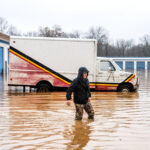With the official start of hurricane season on June 1, insurers and claims professionals should prepare for what has the potential to be one of the most volatile seasons in memory. An environment shaped by rapid storm intensification and flooding adds pressure to professionals, with increased risks, rising costs, and supply chain challenges impacting recovery and remediation efforts.
The National Oceanic and Atmospheric Administration is forecasting a 60% chance of above-normal activity. With as many as five major hurricanes expected, the warning signs are clear. Yet it’s not just the number of storms that should concern insurers and claims professionals, it’s how those storms are behaving.
We are entering an era of faster, wetter, more unpredictable hurricanes and insurers and claims professionals must prepare for the potential challenges of the 2025 season.
Rapid Intensification
Historically, it was rare to see a hurricane jump from Category 2 to Category 5 in less than two days. Now it is happening regularly. Between 1980 and 2017, only two such rapid intensification events were recorded in the Atlantic. Since 2017, we’ve seen two or more every single season.

This matters for catastrophe response because it tightens the timeline for adjusters to prepare for clients and raises the personal risks. Where professionals once had up to 72 hours to mobilize, they may now have just 12. In the past, being the sole adjuster on an island ahead of a storm was a calculated risk. Today, it can quickly become a logistical and safety crisis, roads can wash out, communications can fail, and thousands of claims may need urgent attention, all before basic services like power or water are restored.
It’s not just the wind anymore
There’s also been a significant shift in the water damage profile of these events. “Wet hurricanes” are dumping record-breaking rainfall. For example, Tropical Storm Sarah dropped 48 inches in parts of Central America in just 24 hours last year. That’s more than some towns receive in a full year.
At the same time, “dry hurricanes” are emerging, high-wind systems with minimal rainfall that can cause violent structural damage without triggering the usual rain-driven alerts. These storms catch communities off guard, and when secondary moisture damage sets in, it escalates the losses dramatically.
For the claims industry, this means higher losses, more complex cause-of-loss analysis, and longer remediation timelines.
Inflation and Shortfalls
Structural constraints across the Caribbean are slowing post-storm recovery. Construction materials are in short supply, and skilled labor has become increasingly threatened due to outmigration and U.S. demand. McLarens estimates a 25% rise in reconstruction costs in some island markets compared to pre-pandemic levels.
At the same time, insurance buyers are turning to the surplus lines market in response to shrinking local underwriting capacity, particularly in Puerto Rico and the Eastern Caribbean. Yet this shift comes with trade-offs: higher premiums, tighter terms, and reduced flexibility. Today, as much as 80% of property CAT capacity in the region is now sourced from U.S. and European carriers.
Licensing And Compliance Pressures
Another constraint lies in regulation. Caribbean jurisdictions are tightening licensing and compliance requirements for claims professionals. The previous rules regarding sponsorship and in-market authority are now being enforced. Companies that aren’t prepared for local compliance may experience delays in getting started, which can be quite significant when every hour counts.
Working closely with carriers and local authorities to stay ahead of these shifts is crucial, but the message is clear: technical capability is no longer enough. You need boots on the ground, pre-storm clearance, and robust local relationships ahead of storms and alerts.
The Market Is Evolving
As risk becomes more systemic, clients and markets are reevaluating how catastrophe risk is underwritten and insured. There is a rise in interest in parametric insurance, deductible buybacks, and event-triggered policies. These mechanisms offer faster payout options but require enhanced data and verification standards, including engineer-certified valuations, which are often subject to annual revalidation.
This reflects a larger trend towards climate-aware underwriting. As demands evolve from not only insurers and reinsurers but also regulators, governments, and end clients, claims professionals must evolve from addressing localized storm effects to preparing for full-island event scenarios.
The 2025 hurricane season is expected to bring faster, wetter, and more volatile storms. Rapid intensification, severe flooding, and shifting storm patterns are compressing response windows and complicating claims. At the same time, rising costs, labor shortages, regulatory pressures, and tighter insurance markets demand a more proactive, locally grounded, and climate-aware approach from insurers and adjusters across the Caribbean.
Diaz is regional director – Caribbean for McLarens.
Was this article valuable?
Here are more articles you may enjoy.

 Tesla Drivers Are Buying Escape Tools and Cars to Avoid Getting Trapped Inside
Tesla Drivers Are Buying Escape Tools and Cars to Avoid Getting Trapped Inside  ‘Door Knocker’ Roofers Were Everywhere. NC Farm Bureau Saw an Opportunity
‘Door Knocker’ Roofers Were Everywhere. NC Farm Bureau Saw an Opportunity  Flooding in California Leads to Soaked Roads, Water Rescues and 1 Death
Flooding in California Leads to Soaked Roads, Water Rescues and 1 Death  Wells Fargo Sued by Ex-Manager Who Said Bank Faked Diversity
Wells Fargo Sued by Ex-Manager Who Said Bank Faked Diversity 